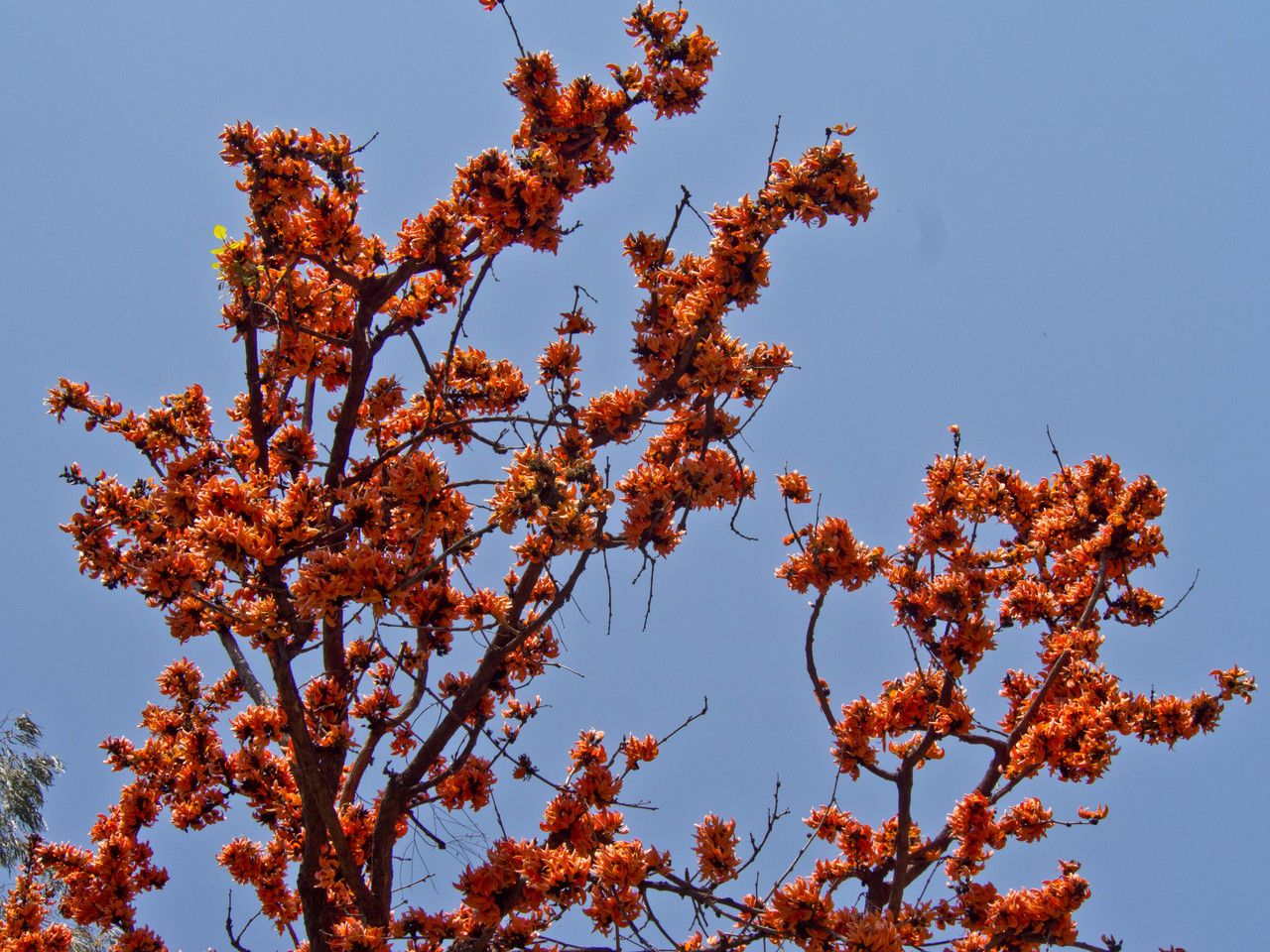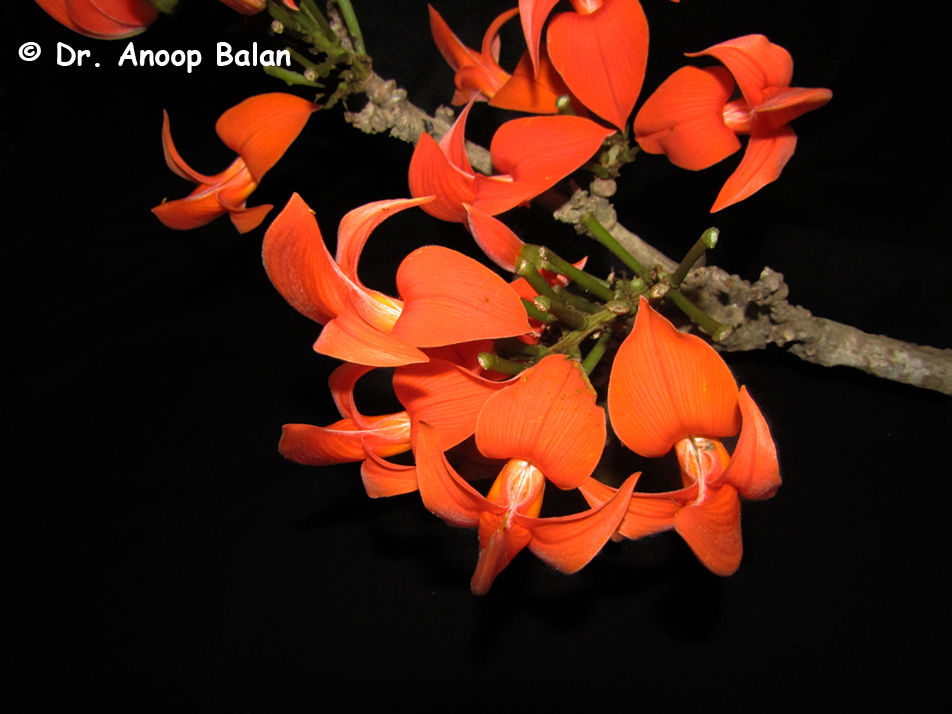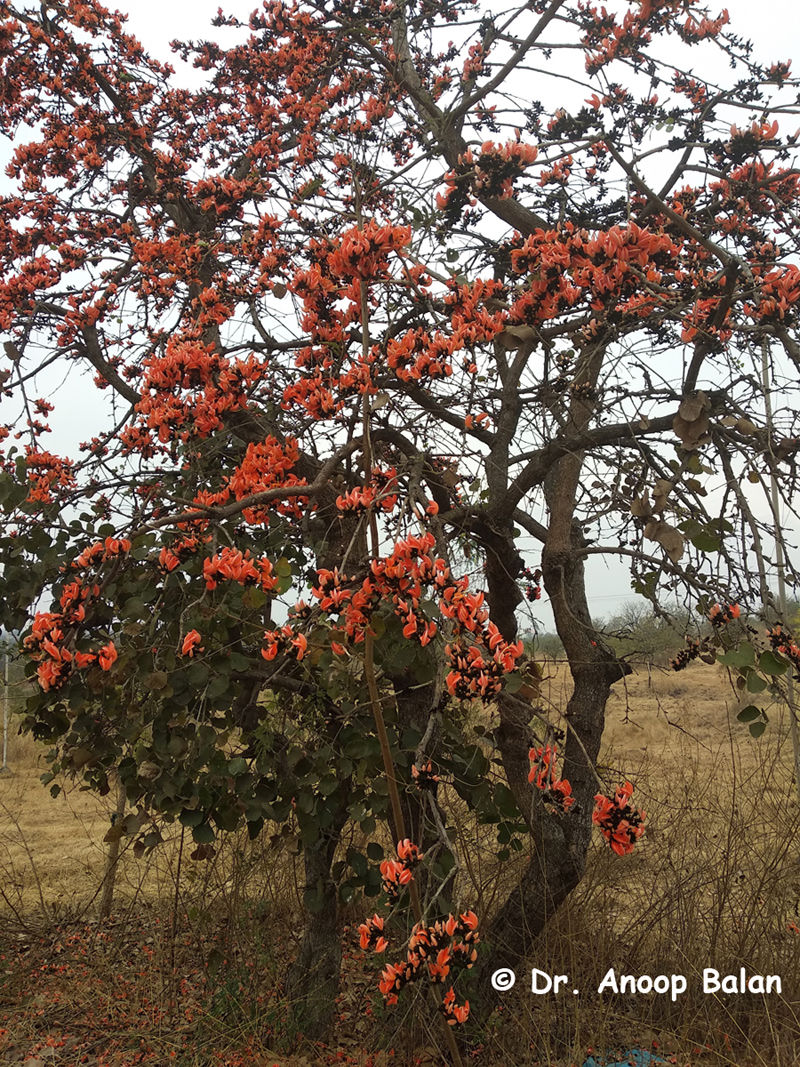Flame of the Forest, Palash, Kesudo
butea monosperma
Also known as: ["Palash","Kesudo","Bengal Kino","Dhak"]
Overview
A deciduous tree native to the Indian subcontinent, known for its vibrant orange-red flowers that bloom in clusters, typically in the dry season.
Benefits & Perks
["long-flowering","wildlife attractant (bees, butterflies, birds)","drought tolerant"]
Botanical Classification
| Phylum: | Magnoliophyta |
| Class: | Magnoliopsida |
| Order: | Fabales |
| Family: | Fabaceae |
| Genus: | Butea |
| Botanical Name: | Butea monosperma |
Plant Characteristics
Basic Information
- Category: Trees
- Suitable Location: outdoor garden in full sun, protected from strong winds
- Suitable For:
- Is Weed: No
- Allergenicity: low
Environmental Needs
- Climate: {"temperatureRange":"10–45°C"}
- Hardiness: {"zones":"9–11"}
- Misting: rarely required, only if ambient humidity is very low
- Drainage: Fast-draining to prevent waterlogging.
- Soil Type: Well-draining, loamy soil with organic matter; can tolerate poor soils but thrives with enrichment.
Maintenance Level
- Maintenance Level: moderate
- Toughness Level: high
- Pruning Frequency: Annually in late winter or early spring before new growth begins.
- Pruning Intensity: Moderate; remove up to one-third of old growth to rejuvenate the plant.
Care Details
Ideal Sunlight Coverage:
Full sun to partial shade; 6–8 hours of direct sunlight daily, with some afternoon shade in hot climates.
Sunlight Tolerance Tips:
Acclimate plants gradually to intense sunlight; protect from harsh midday sun to prevent scorching; adjust placement based on indoor/outdoor conditions.
Care Requirements
Care Difficulty
moderatemoderate
Sunlight
full sun
Rotate plant for even light exposure; use shade cloth in extreme heat; avoid direct sun on leaves during peak hours.
Watering
every 7–10 days during growing season, reduce in winter
Water thoroughly but infrequently to encourage deep roots; allow soil to dry partially between waterings; avoid waterlogging.
Soil
well-drained, loamy soil with moderate organic content
pH: Slightly acidic to neutral, pH 6.0–7.0.
Ensure soil is not compacted; avoid heavy clay mixes; amend with organic matter for better structure.
Temperature
Thrives in warm conditions, 20–35°C (68–95°F); tolerates mild frosts but prefers stable warmth.
Protect from frost; ensure good air circulation in heat; adjust watering with temperature.
Fertilizing
every 4–6 weeks during active growth with balanced fertilizer
Fertilize in spring and summer only; apply to moist soil to prevent root burn; flush soil occasionally to prevent salt buildup.
Propagation
Methods
Stem cuttings or seeds; stem cuttings are more reliable for home growers.
Step-by-Step Propagation Guide
- Take 4–6 inch cuttings.
- Remove lower leaves.
- Dip in rooting hormone.
- Plant in medium.
- Keep moist and warm.
Best Time: Spring or early summer when the plant is actively growing.
Environment
Warm, humid environment with indirect light; maintain consistent moisture.
Medium
Well-draining mix of perlite and peat moss or cactus mix.
Hormone
Recommended to use rooting hormone for faster root development.
Timeline
Roots may develop in 4–8 weeks; establish in new pot after 3–6 months.
Tools Needed
Pruning shears, rooting hormone, small pots, misting spray bottle.
Quick Tips
Use healthy, non-flowering stems; maintain high humidity with a plastic cover; avoid direct sun.
Pruning & Repotting
Pruning Guide
Method
Selective thinning and heading back to shape the plant and improve air circulation.
Pruning Plan
Prune to maintain shape, encourage bushiness, and remove dead or diseased wood.
Tools
Pruning shears, loppers, gloves, disinfectant.
Checklist
Disinfect tools; prune dead/diseased wood first; make clean cuts just above buds or branches.
Repotting Guide
Best Season
Early spring before active growth starts.
Pot Size
Increase pot size by 2–5 cm (1–2 inches) in diameter.
Method
Remove plant gently; trim roots if needed; place in new pot with fresh soil; water lightly.
Suggestions
Repot every 2–3 years or when roots fill the pot; beneficial for young, fast-growing plants.
Checklist
Choose appropriate pot size; use fresh, well-draining soil; water sparingly after repotting.
Advanced Care Tips
Watering Mastery
Watering Checklist
Check soil moisture before watering; water deeply; ensure drainage; adjust seasonally.
How to Apply Water Properly
Water at the base of the plant, ensuring moisture reaches the root zone; water early in the morning to minimize evaporation; ensure excess water drains away to prevent root rot.
Watering Schedule Tips
Water deeply once a week during active growth in spring and summer; reduce frequency to every 2–3 weeks in fall and winter. Adjust based on rainfall and soil dryness.
Soil Improvement
Add compost or well-rotted manure for fertility; mix sand or perlite for drainage; ensure aeration with organic matter.
Temperature Stress Management
Signs of Temperature Issues
Chlorosis or leaf drop in cold stress; wilting or scorching in excessive heat.
Cold Stress
Growth slows or halts; leaves may turn yellow or drop; risk of frost damage in prolonged cold.
Solution: Move to a sheltered location; provide frost protection; reduce watering in cold periods.
Hot Stress
Leaves may wilt, scorch, or drop; growth may slow due to excessive transpiration.
Solution: Provide shade during peak heat; increase humidity; water deeply but avoid overwatering.
Fertilizing Guide
Fertilizing Checklist
Use diluted fertilizer; apply during active growth; avoid winter feeding.
Fertilizing Method
Use balanced, water-soluble fertilizer diluted to half strength every 4–6 weeks during growing season; avoid fertilizing in winter.
Common Problems & Solutions
Toxicity Warning
Cats
ToxicButea monosperma is toxic to cats, particularly the seeds and bark, which can cause severe gastrointestinal and systemic toxicity. Cats are sensitive to these compounds, and ingestion can lead to serious health issues.
⚠️ Symptoms:
🌿 Toxic Parts:
⚡ Toxic If:
if eaten
Dogs
ToxicThe seeds and bark of Butea monosperma are toxic to dogs, potentially causing severe gastrointestinal upset and systemic effects. The toxins can lead to significant discomfort and require veterinary attention.
⚠️ Symptoms:
🌿 Toxic Parts:
⚡ Toxic If:
if eaten
Humans
Slightly ToxicButea monosperma contains compounds that can cause mild gastrointestinal distress and allergic reactions in humans. The seeds and bark are the most toxic parts, containing substances that may interfere with digestion and cause irritation.
⚠️ Symptoms:
🌿 Toxic Parts:
⚡ Toxic If:
if eaten
Frequently Asked Questions
Q: What is the significance of Butea monosperma in Indian culture?
A: It is considered sacred in Hinduism and is often associated with spring festivals like Holi.
Q: Is the tree suitable for urban landscaping?
A: Yes, it is drought-tolerant and can thrive in urban environments with adequate space.
Q: Are the flowers edible?
A: The flowers are sometimes used in traditional dishes, but caution is advised due to potential unknown toxicity.
Quick Reference
| Family: | Fabaceae |
| Care: | moderate |
| Light: | full sun |
| Water: | every 7–10 days during growi |
Get Expert Care Tips
Download the Plantious app for personalized care reminders and plant identification!
Google Play App Store








